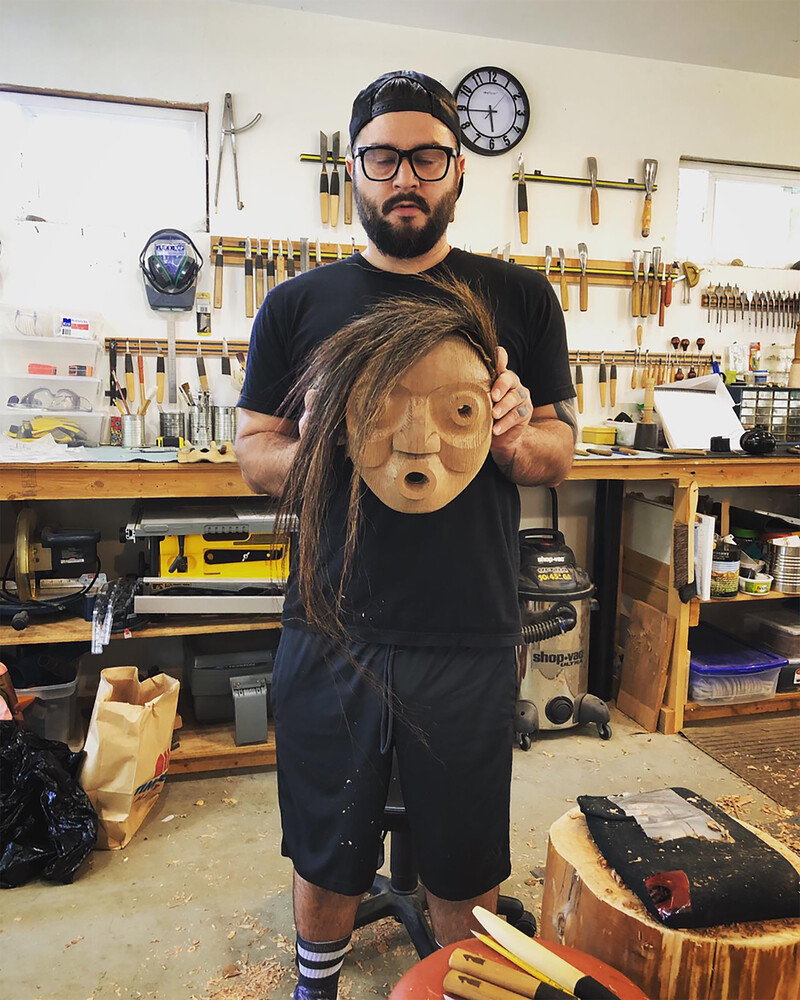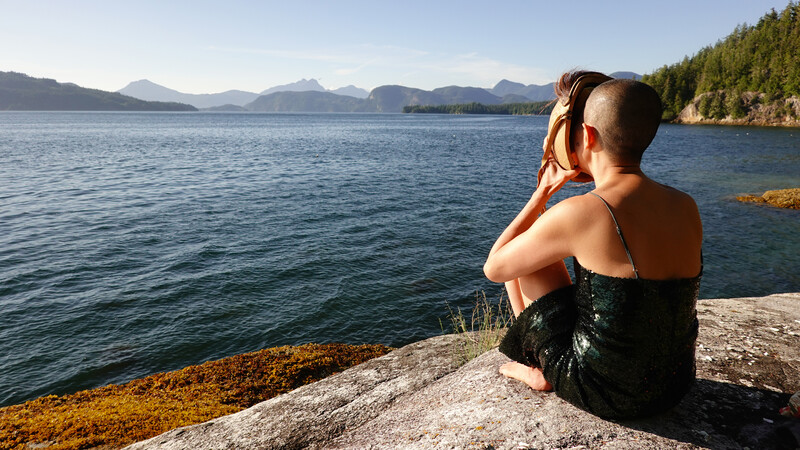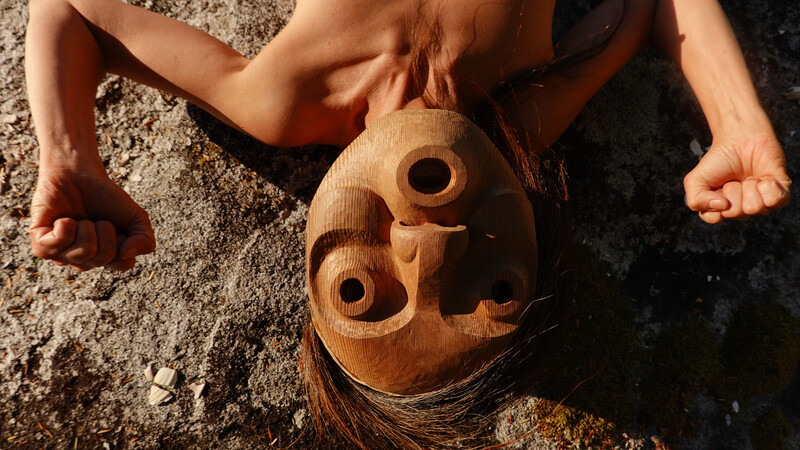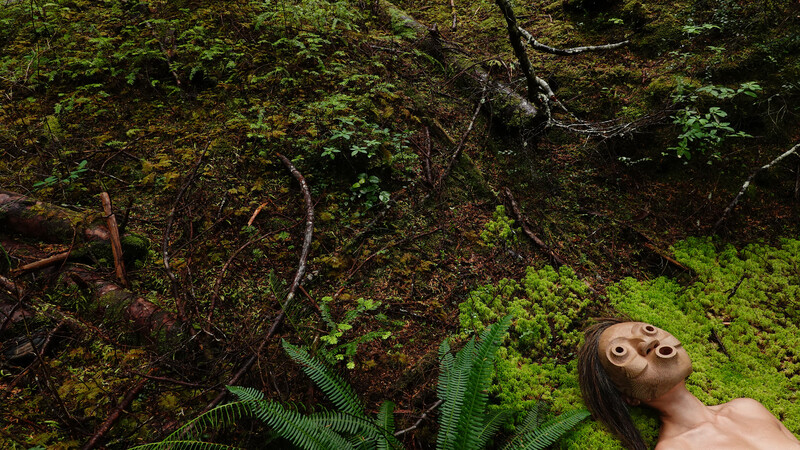- 11.0Cover
- 11.1How to Read this Broadsheet
- 11.2Power of PeopleAyodamola Tanimowo Okunseinde
- 11.3Walking through Mishibizhiw: Challenging the Measured Pace of ColonizationTasha Beeds
- 11.4Permanent PrecarityMostafa Henaway
- 11.5Soundpace // Eavesdropping on the Process of Dilettante ComposerOana Avasilichioaei
- 11.6Bringing the Decolonial into Kinesiology, Health, and Sport EthicsJanelle Joseph, Debra Kriger
- 11.7The Territory Between UsLee Su-Feh, Bracken Hanuse Corlett
- 11.8"Ensuring I Can Let People Know They Exist": Continuities of Black Feminist Publishing in TorontoAdwoa Afful, Cleopatria Peterson, Corinn Gerber
- 11.9Wayside SangCecily Nicholson
- 11.10Full StopMaandeeq Mohamed
- 11.11In Spite of DefeatismJacob Wren
- 11.12Glossary
The Territory Between Us
- Lee Su-Feh
- Bracken Hanuse Corlett
In 2018, I approached Bracken Hanuse Corlett (Wuikinuxv/Klahoose) to ask if he would carve me a mask. We had spent a year talking with each other—over coffee, via text messages and emails. These conversations were between two artists getting to know each other. They touched upon our relationship to the land and waters where we live, to art, to traditions, and to our families and loved ones. We talked about our respective relationships to masks in general.
I was born and raised in Malaysia, where I was indelibly marked by teachers and mentors trying to figure out what it meant to make contemporary Asian performance out of the remnants of colonialism and ruptured traditions. As a teenager, I decided I wanted to be a dancer while watching my first dance teacher, Marion D’Cruz, rehearse her mask solo Bacchanale (first performed 1981) in her mask-lined living room. Some years later, Marion taught me this solo as a gift to take on my journey away from home to Paris, where I was going to pursue my dreams of becoming a dancer. While I never performed this work in public, I carried it, along with the mask and costume that Marion had given me, like a talisman, to keep me grounded amid new adventures.
Masks carry deep significance for Bracken as well. He tells me:
My art practice is interdisciplinary and collaborative. It is also rooted in the material visual culture of the Wuikinuxv and Klahoose Peoples. The guiding ethic and aesthetic of the process is Wuulhu. “Wuulhu” means “to fuse together” in the Wuikila language. To me, this means the process of making is always connected regardless of medium. It is being unapologetically in love with the stars, the sky, the water. and the land. . . . Around fifteen years ago I started to learn carving and design from my relatives, the Heiltsuk artists Bradley Hunt and his sons Shawn and Dean. This time at their studio gave me a better technical understanding of the art, but I was also encouraged to choose my own conceptual path with it. To me, a mask is a vessel that is meant to be concealed, shared, activated, and listened to. This mask for Su-Feh came from a red cedar tree that had fallen in a forest fire in 1890. The journey of this mask started before European contact. It transformed from a small sapling into a towering giant. It survived an inferno and rested in the ground while seasons changed on its skin for more than a hundred years. This mask is an exchange between artists that lives outside of commodification. It was created from the ground, water, fire, and the conversations between us.

Bracken and I have often talked about the mask as a representation of the territory between us: me, an immigrant, and him, an Indigenous person of the West Coast of Turtle Island. We would refer to the mask as “The Territory Between Us.”
At this point, the question that interested me was: How might the human body write choreography into a mask? And then: How might the mask write choreography onto human bodies? You could say that I was asking Bracken, the carver, to choreograph me.
My sole task upon receiving the mask was simply to submit to it, to be guided by it.
This mask became the starting point of my second year as artist-in-residence at Dancemakers Centre for Creation in Toronto, alongside a cohort of other artists. I had imagined a process where others and I would put on the mask, listen to what it demanded from our bodies, and simply make a dance for it. I wanted to create a score that came out of us collectively listening to the mask. I hoped for a score that could eventually be danced by anybody willing to submit to the demands of the mask.
The mask, however, had other ideas. It said no.
Or: No, not yet.
I heard the no as a feeling of uncertainty in my body when I put it on in front of other people. I heard the no in the questions and uncertainties of the artists who put on the mask. I heard the no in the look of uncertainty I noted in colleagues to whom I showed the mask.
“Should I be wearing this mask?” “Should you be wearing this mask?”
Questions both spoken and unspoken.

These uncertainties were already present in my conversations with Bracken. We talked about the complicated territory of who had a right to wear this mask: despite being carved specifically for me and not bound by traditional ceremonies and Protocols, it was still informed by Bracken’s West Coast training and traditions. We wondered if he even had a right to give me this mask. We talked about the politics, the permissions, the historical hurts that have happened in a long history of settlers taking things that weren’t theirs to take. I didn’t want to be a settler who stole things.
What struck me most was listening to Bracken talk about carving as an act of responsibility to the life-giving energy in a raw piece of cedar. When he handed me the mask, he was handing me the responsibility to continue taking care of it, to listen to the cedar. The mask is, after all, a part of a fallen cedar. It is part of the land, and when I listen to it, I am listening to my responsibilities to the land and to the relationships that are part of it.
I decided to listen to this “no” I heard. I submitted to the mask. I stopped trying to “make” a dance with the mask and instead acknowledged the mask as a being with a life of its own, and not an object for me to impose my will upon.

The mask’s presence became a witness to all that I did, a being I had to be accountable to and that reminded me of things more important than the production of work for the market.
I have what I call “consultation dances” with the mask: private moments of intimacy, sometimes in studio, but most often in the forest, by the ocean. I look through its eyes, but they do not line up with mine. I have to move my body in response to this new view of the world. I have to listen harder. Feel more through my skin, my feet, my whole body. I make sounds in the mask as a way of echolocating myself. I listen harder to the sounds around me as a way to figure out where I am.
These dances are to figure out my next step in my query.
A query about what I don’t know about myself.
A query about what I don’t know about the land I am on.
A query into all my relations.

Score for Dancing across Distances: Openings and Obstacles
A set of tasks to dance with, alone or with others.
A set of tasks to solve problems with.
A set of tasks to fight with,
To love with.
Start with your body.
Follow openings.
“Openings” are pleasure, curiosity, or desire.
Follow openings.
Yield to or soften around obstacles.
“Obstacles” are pain, boredom, or resistance.
Yield around obstacles.
To yield is neither to push into nor to pull away,
But to soften around the obstacle
The way your palm might soften around a cactus
In order not to be hurt by the spines.
Yield so that the obstacle is not ignored,
But is acknowledged, held with care.
Observe the consequences of each action.
(One little movement in one part of the body
Connects to every movement in the rest of the body;
One little flutter of a wing in one part of the planet
Is related to earth-shifting events in another part.)
Notice the changed shape of you.
Notice new pleasures, new obstacles.
Repeat.
Apply to everything.
(Start with your body.)
As I write this piece, I realize that I am in a long, durational dance with the mask. I dance with the mask as a way of dancing with the land, with hopes of bypassing the colonial ways my body has learned to relate to the planet and to the human and nonhuman beings it holds. I am trying to figure out, even as I am dancing, how to invite others into this dance with me, if even for a brief moment. This writing is one invitation. Thank you for reading. Thank you for dancing with me.
Lee Su-Feh’s work as a performance-maker encompasses choreography, teaching, dramaturgy, writing, and community organizing. Born and raised in Malaysia, Lee moved to Vancouver in 1988 and has since created a body of work that interrogates the contemporary body as a site of intersecting and displaced histories and habits. In 1995, she co-founded battery opera performance with David McIntosh, and together they have led the company to earn a reputation for being “fearlessly iconoclastic,” producing award-winning works that take place in theatres, on the street, in hotel rooms, and in print.
See Connections ⤴
Bracken Hanuse Corlett is an interdisciplinary artist from the Wuikinuxv and Klahoose Nations. Corlett’s work incorporates Northwest Coast aesthetics and symbols, and fuses painting and drawing with digital media, audio-visual performance, animation and narration. He is a graduate of the En’owkin Centre of Indigenous Art and went to Emily Carr University of Art + Design. He has studied Northwest Coast art with acclaimed Heiltsuk artists Bradley Hunt and his sons Shawn Hunt and Dean Hunt. His work has been exhibited and presented at Grunt Gallery, Vancouver; Museum of Anthropology (MOA), Vancouver; the Winnipeg Art Gallery and Urban Shaman, Winnipeg; the MacKenzie Art Gallery, Regina; ImagineNative and Toronto International Film Festival, Toronto.
See Connections ⤴